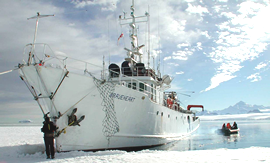The Braveheart brought us safely to Raoul Island just after dawn this morning, after passing the southern Kermadecs in the night. We saw several humpbacks breaching as we steamed to our anchorage. Shortly after arrival we dropped our birders Chris and Mark on Raoul – we won’t see them for the next two weeks, as they will be ashore collecting data on the resident seabird population. We will (hopefully!) be picking them up to come home with us when we leave.

The team attempt to satellite tag a humpback whale off Raoul Island.
It turns out that the task of locating and tagging some of the largest animals on the planet is less simple than it sounds. Humpback whales are indeed very large, but they are also fast and elusive and underwater most of the time. Our team works in two small tenders, with each boat gathering data on separate pods of whales. The morning was spent following pods of 1-3 individuals, who exhibited the full range of humpback acrobatics (pectoral slaps, breaching, tail slaps, random rolls on the surface) while staying just out of reach of our taggers and biopsy samplers.
The afternoon’s efforts were more successful, with Simon managing to successfully deploy our first satellite tag and Claire got a biopsy sample of the whale. Over on the other boat Olive recorded some great song, most likely from a group with a mother and new calf accompanied by two other adults. We have an early start tomorrow to get some work done while the weather is good.
By James Tremlett












